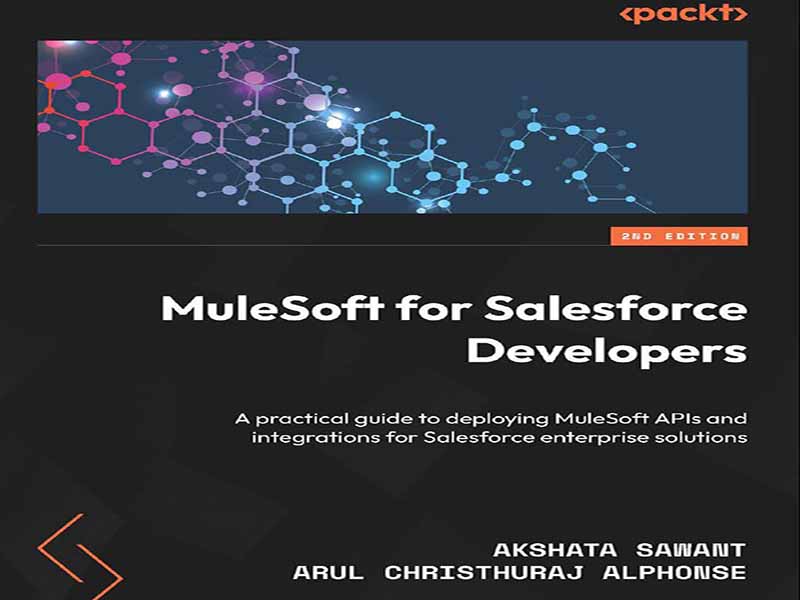- عنوان کتاب: MuleSoft for Salesforce Developers -A practical guide to deploying MuleSoft APIs and integrations for Salesforce enterprise solutions
- نویسنده: Akshata Sawant, Arul Christhuraj Alphonse
- حوزه: توسعه API
- سال انتشار: 2025
- تعداد صفحه: 518
- زبان اصلی: انگلیسی
- نوع فایل: pdf
- حجم فایل: 14.2 مگابایت
کتاب MuleSoft برای توسعهدهندگان Salesforce به شما کمک میکند تا با استفاده از پلتفرم Anypoint و Anypoint Studio شرکت MuleSoft، راهکارهای سازمانی پیشرفتهای با قابلیتهای یکپارچهسازی انعطافپذیر و مقیاسپذیر بسازید. اگر شما یک توسعهدهنده Salesforce هستید که به دنبال شروع کار با این ابزار قدرتمند هستید، این کتاب به سرعت شما را با این ابزار آشنا میکند و مهارتهای توسعهدهنده یکپارچهسازی شما را افزایش میدهد. این راهنما که با توضیحات گام به گام مفاهیم کلیدی، مثالهای عملی و سوالات خودارزیابی تکمیل شده است، با معرفی اصول MuleSoft و اتصال مبتنی بر API آغاز میشود. سپس شما را در چرخه عمر API و Anypoint Studio IDE همراهی میکند و شما را برای ایجاد برنامههای Mule آماده میکند. شما اجزای اصلی MuleSoft و پلتفرم Anypoint را بررسی خواهید کرد و در ساخت، تبدیل، ایمنسازی، آزمایش و استقرار برنامهها با استفاده از طیف گستردهای از اجزا، تخصص کسب خواهید کرد. در نهایت، یاد خواهید گرفت که چگونه از کانکتورها برای ادغام MuleSoft با Salesforce برای رسیدگی به موارد استفاده مختلف استفاده کنید و همچنین نکات ارزشمندی برای صدور گواهینامه و مصاحبه دریافت خواهید کرد. در پایان این کتاب، در ساخت یکپارچهسازیهای MuleSoft در مقیاس سازمانی احساس اعتماد به نفس خواهید کرد. این کتاب همچنین شما را برای قبولی در گواهینامه اساسی MuleSoft آماده میکند: توسعهدهنده معتبر MuleSoft (MCD) – سطح 1. این کتاب برای توسعهدهندگان Salesforce که میخواهند با MuleSoft شروع به کار کنند، طراحی شده است. با افزایش تقاضا برای راهحلهای میان ابری که MuleSoft را با Salesforce یا پیشنهادات ابری آن (مانند Service Cloud، Marketing Cloud و Commerce Cloud) ادغام میکنند، این کتاب به عنوان یک منبع ضروری عمل خواهد کرد. معماران Salesforce نیز مفاهیم مطرح شده را برای طراحی راهحلهای Salesforce مفید خواهند یافت. دانش اولیه از یک زبان برنامهنویسی و آشنایی با مفاهیم ادغام مفید خواهد بود. انتظار میرود کمی تجربه در توسعه Salesforce و APIهای Salesforce (SOAP API، REST API، Bulk API یا Streaming API) داشته باشید. فصل 1، مقدمهای بر APIها و MuleSoft، فناوریهای بدون کد و کم کد، APIها و ادغامها، محصولات MuleSoft، شبکههای برنامه و رویکرد اتصال مبتنی بر API را پوشش میدهد. فصل 2، طراحی API شما، چرخه عمر API و نحوه ایجاد مشخصات API با استفاده از RAML، سرویسهای وب HTTP و قطعات API را بررسی میکند. این فصل همچنین شامل افزودن مستندات به APIها و دانلود مشخصات API از پلتفرم Anypoint است. فصل 3، بررسی Anypoint Studio و Anypoint Code Builder (ACB)، نحوه دانلود و نصب Anypoint Studio و Anypoint Code Builder، توسعه یک برنامه جدید Mule و اجرای آن در هر دو ابزار را پوشش میدهد. فصل 4، مقدمهای بر اجزای اصلی، اجزای اساسی MuleSoft، از جمله کنترلهای جریان (Choice Router، First Successful، Round Robin و Scatter-Gather)، محدودهها (Flow، Subflow، For Each، Parallel For Each، Async، Cache، Try و Until Successful) و سناریوهای مدیریت خطا را بررسی میکند. فصل 5، همه چیز درباره پلتفرم Anypoint، به بررسی اجزای پلتفرم Anypoint، از جمله Design Center (API Designer)، Exchange، API Manager، Runtime Manager و Anypoint Monitoring میپردازد. در پایان این فصل، شما خواهید فهمید که چگونه با استفاده از Design Center یک API ایجاد کنید، API را در Exchange منتشر کنید، API را در API Manager برای اجرای سیاستها ایجاد کنید، از Runtime Manager استفاده کنید و برنامهها را در پلتفرم Anypoint نظارت کنید. فصل 6، یادگیری DataWeave، DataWeave را برای مبتدیان معرفی میکند. این فصل اصول اولیه، از جمله DataWeave چیست، نحوه ایجاد اسکریپتها، نحوه اضافه کردن نظرات و جزئیات مربوط به انواع دادهها، قالبهای دادهها، عملگرها، متغیرها، توابع، انتخابگرها، دامنهها و شرطها را پوشش میدهد. فصل 7، تبدیل با DataWeave، به بررسی عمیقتر ماژولهای DataWeave و برخی از توابع رایج در سناریوهای دنیای واقعی میپردازد. همچنین نحوه استفاده از کامپوننت Transform Message برای کار با DataWeave در Anypoint Studio را پوشش میدهد. فصل 8، ساخت برنامه Mule شما، به شما میآموزد که چگونه یک برنامه Mule را با استفاده از فایلهای پیکربندی و ویژگیهای مختلف بسازید. همچنین در مورد Scheduler Endpoint، روتر APIkit و Object Store بحث میکند. فصل 9، استقرار برنامه شما، گزینههای مختلف استقرار موجود در MuleSoft را پوشش میدهد. این فصل نحوه استقرار یک برنامه در CloudHub، نحوه دانلود و نصب یک سرور محلی Mule و نحوه استقرار برنامه Mule در سرور محلی را توضیح میدهد. فصل 10، ایمنسازی API شما، بر ایجاد و اعمال سیاستها در پلتفرم Anypoint، ایمنسازی پیکربندیها، افشای برنامههای Mule از طریق HTTPS و مدیریت رمزگذاری و رمزگشایی تمرکز دارد. فصل 11، آزمایش برنامه شما، MUnit و MUnitTools را به همراه عملیات مختلف معرفی میکند. این فصل نحوه ایجاد مجموعههای آزمایشی و موارد آزمایشی با استفاده از MUnit را نشان میدهد و بررسی میکند که چگونه MUnit میتواند فرآیند توسعه، از جمله استفاده از ضبطکننده تست را سرعت بخشد. فصل 12، ادغام MuleSoft با Salesforce، نحوه ادغام MuleSoft با Salesforce CRM با استفاده از رابط Salesforce را توضیح میدهد. این فصل دو رویکرد ادغام را پوشش میدهد: مبتنی بر API، که در آن شما…
MuleSoft for Salesforce Developers will help you build cutting-edge enterprise solutions with flexible and scalable integration capabilities using MuleSoft’s Anypoint Platform and Anypoint Studio. If you’re a Salesforce developer looking to get started with this powerful tool, this book will get you up to speed quickly, enhancing your integration developer skills. Complete with step-by-step explanations of key concepts, practical examples, and self-assessment questions, this guide begins by introducing the fundamentals of MuleSoft and API-led connectivity. It then walks you through the API lifecycle and the Anypoint Studio IDE, preparing you to create Mule applications. You’ll explore the core components of MuleSoft and the Anypoint Platform, gaining expertise in building, transforming, securing, testing, and deploying applications using a wide range of components. Finally, you’ll learn how to use connectors to integrate MuleSoft with Salesforce to address various use cases, as well as receive valuable tips for certification and interviews. By the end of this book, you will feel confident building MuleSoft integrations at an enterprise scale. This book will also prepare you to pass the fundamental MuleSoft certification: MuleSoft Certified Developer (MCD) – Level 1. This book is designed for Salesforce developers who want to get started with MuleSoft. As demand grows for cross-cloud solutions that integrate MuleSoft with Salesforce or its cloud offerings (such as Service Cloud, Marketing Cloud, and Commerce Cloud), this book will serve as an essential resource. Salesforce architects will also find the concepts covered useful for designing Salesforce solutions. Basic knowledge of a programming language and familiarity with integration concepts will be helpful. Some experience with Salesforce development and Salesforce APIs (SOAP API, REST API, Bulk API, or Streaming API) is expected. Chapter 1, Introduction to APIs and MuleSoft, covers no-code and low-code technologies, APIs and integrations, MuleSoft products, application networks, and the API-led connectivity approach. Chapter 2, Designing Your API, explores the API lifecycle and how to create API specifications using RAML, HTTP web services, and API fragments. This chapter also includes adding documentation to APIs and downloading API specifications from the Anypoint Platform. Chapter 3, Exploring Anypoint Studio and Anypoint Code Builder (ACB), covers how to download and install Anypoint Studio and Anypoint Code Builder, develop a new Mule application, and run it in both tools. Chapter 4, Introduction to Core Components, examines fundamental MuleSoft components, including flow controls (Choice Router, First Successful, Round Robin, and Scatter-Gather), scopes (Flow, Subflow, For Each, Parallel For Each, Async, Cache, Try, and Until Successful), and error handling scenarios. Chapter 5, All About Anypoint Platform, delves into the components of Anypoint Platform, including Design Center (API Designer), Exchange, API Manager, Runtime Manager, and Anypoint Monitoring. By the end of this chapter, you’ll understand how to create an API using Design Center, publish the API in Exchange, create the API in API Manager to enforce policies, utilize Runtime Manager, and monitor applications on Anypoint Platform. Chapter 6, Learning DataWeave, introduces DataWeave for beginners. It covers the basics, including what DataWeave is, how to create scripts, how to add comments, and details on data types, data formats, operators, variables, functions, selectors, scopes, and conditionals. Chapter 7, Transforming with DataWeave, delves deeper into DataWeave modules and some of the most commonly used functions in real-world scenarios. It also covers how to use the Transform Message component to work with DataWeave in Anypoint Studio. Chapter 8, Building Your Mule Application, teaches you how to build a Mule application using various configuration and properties files. It also discusses the Scheduler Endpoint, APIkit router, and Object Store. Chapter 9, Deploying Your Application, covers the different deployment options available in MuleSoft. This chapter explains how to deploy an application to CloudHub, how to download and install a Mule on-premises server, and how to deploy the Mule application to the on-premises server. Chapter 10, Securing Your API, focuses on creating and applying policies in Anypoint Platform, securing configurations, exposing Mule applications via HTTPS, and handling encryption and decryption. Chapter 11, Testing Your Application, introduces MUnit and MUnitTools, along with different operations. It demonstrates how to create test suites and test cases using MUnit, and explores how MUnit can speed up the development process, including the use of the test recorder. Chapter 12, MuleSoft Integration with Salesforce, explains how to integrate MuleSoft with Salesforce CRM using the Salesforce connector. It covers two integration approaches: API-based, where you access Salesforce objects via the API for real-time data, and event-based, where you listen to Salesforce topics and process the messages synchronously to the required backend system. Chapter 13, MuleSoft Connectors and Use Cases, explores various MuleSoft modules (File, FTP, SFTP, Database, Slack, SOAP, VM, and JMS). In the File-based module (File, FTP, SFTP), you’ll learn to connect to systems and read files, as well as send files via different connectors. The Database module shows how to configure connectors to specific databases and read/insert records. This chapter also covers modules such as Slack, Web Service Consumer (SOAP), VM, and JMS connectors. Chapter 14, MuleSoft Best Practices, Tips, and Tricks, provides guidelines on MuleSoft best practices, coding standards, and useful tips and tricks. Chapter 15, Certification and Interview Tips, explores career paths within the MuleSoft ecosystem. It discusses MuleSoft certifications, tips for getting certified, available training options, how to contribute to the MuleSoft community, and interview tips for landing your first MuleSoft position. Chapter 16, AI and Automations with MuleSoft, covers Automations with MuleSoft Composer, an introduction to MuleSoft RPA, automating document processing with IDP, and integrating Mule APIs with Agent Force.
این کتاب را میتوانید از لینک زیر بصورت رایگان دانلود کنید:
Download: MuleSoft for Salesforce Developers





































نظرات کاربران